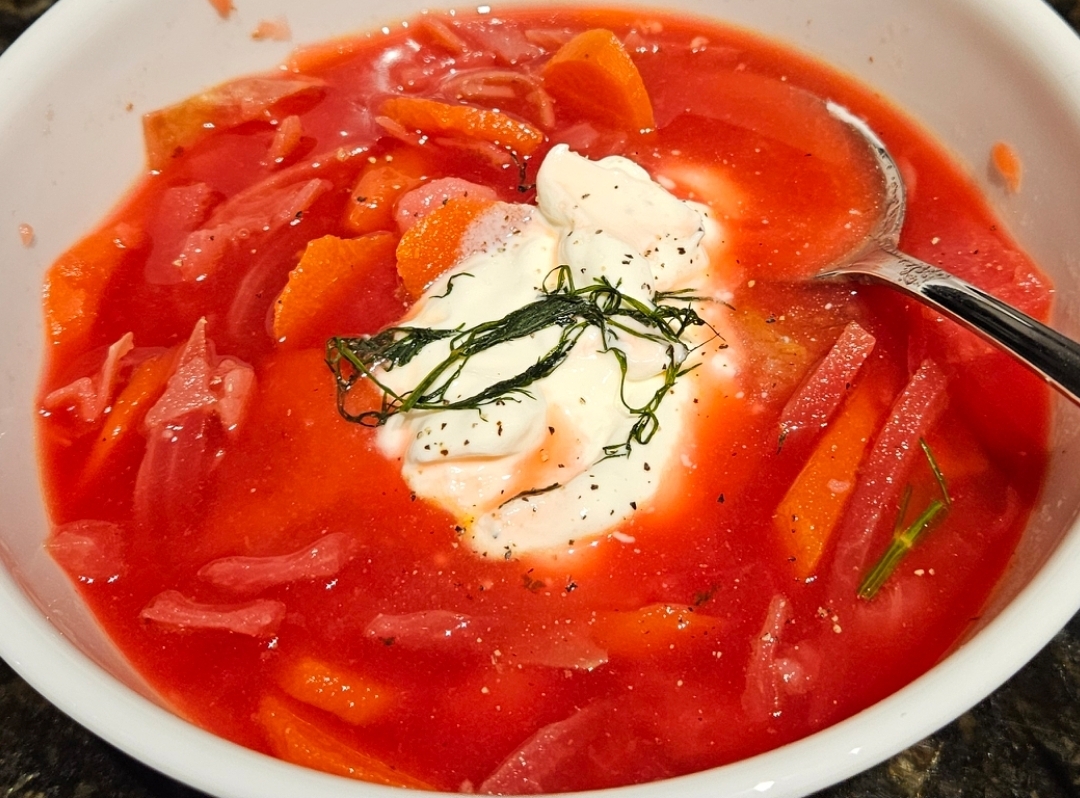Root and Stone Borscht
Warm and comforting, filled with memories of childhood holidays spent with your grandparents.A staple meal found around every Earthren table at some point, Roots and Stone Borscht is made from root vegetables, whatever one has in their fridge, and a few stones for flavour. Meat and beef broth is often used for the dish, but the meat often is omitted, and a vegetable broth can be used instead. Traditionally, it is served with a generous sprinkle of fresh garden dill and a dollop of sour cream on top.
History
Given how Earth Elementals are able to grow plants with ease using magic; fruits, vegetables, and herbs are common ingredients of dishes. Even for the poor during cold winters, beets, garlic, carrots, potatoes, and sorrel all grow well with the limited sunlight in traditional underground homes in Tierra. Cabbage grows less well, but is still usually incorporated. With a few basic staples, one could create a large meal to last many nights, full of nutrition and tasted amazing. Since the beginning, it has quickly spread to everyone's tables, regardless of prosperity.How the stones found their way into the dish is a mystery, as it is certain that the original dish came first. Some claim it was an accident due to someone quickly adding the vegetables to the pot without noticing that a few stones had gotten into the mix. Others suspect it came from a desperate person making an attempt to increase the amount of substance within the dish, and took inspiration from some Earth magic mutated animals. These larger animals are able to use their innate abilities to smash through soil and rocks, and eat the ore, gems, and minerals found deep below. Whatever the reason, it caught on quick. Now, most households couldn't imagine creating the dish without a few chunks of granite or crystals thrown into the pot.
Aside from when a non-Earth Elemental is visiting. They don't digest stones so well...
Appearance
The colour of the borscht is largely dependent on what ingredients are used to prepare it. When beets are used the colour is a deep red, sorrel turns it green, and rye (though rarely used) causes it to be white. Red borscht is most common during winter and fall, while green borscht is the most common during the spring and summer. The rocks or minerals added can also influence the colour, especially if powdered first. Some have even taken to adding mica powder to the dish, giving the soup sparkles along with the colour from the vegetables.Recipe
- In a large pot add beef or vegetable broth, water and the stones or minerals desired (if using). Bring to a boil. (4–6 cups beef broth, to 4–6 cups water)
- Slice the cabbage, add to the boiling broth. (5 cups cabbage)
- If using meat (ex: eye of round), chop it small, and sear all the pieces. (2.3 pounds). Add to the broth.
- Cut up the potatoes into small pieces, rinse, then add to the broth. (4 potatoes)
- Chop celery, carrots, and onion. Cook together, sauté for 5 minutes or until soft. Add to the broth. (2 sticks celery, 3 large carrots, 1 large yellow onion)
- Cut the beets in the Julienne cut style, (keeping a portion of one beet to the side) then fry them for 3–4 minutes. Add blended tomatoes, and the juice of half a lemon. Mix it all together, then add all of it to the broth. (3 beets, 2 fresh tomatoes, juice of 1/2 a lemon)
- Take the previously set aside beets, put them in a blender with a splash of water. Blend fine, then add to the broth.
- Press garlic cloves, add to pot, as well as salt and pepper to taste. (4 cloves garlic)
- Add more broth if required, simmer minimum of 2 hours.
- Serve with a dollop of sour cream and fresh dill on top.


Comments